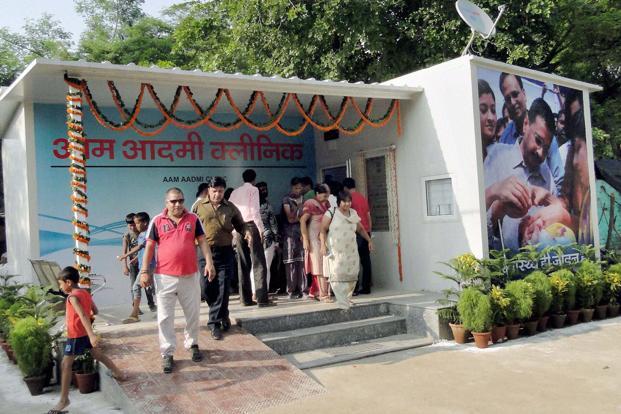By Aaroosh Jairath
Last February, the Aam Aadmi Party or AAP completed two years in power after claiming a decisive majority in the 2015 State elections.
A large part of these two years accounted for a power struggle with the Centre and the then Lieutenant Governor Najeeb Jung over administrative jurisdiction. While the Delhi Government consistently accused the Centre of creating obstacles in their way, they have managed to do a great job especially in the field of Health and Education.
The Health Sector: Hits and Misses
By the end of 2016, about 1000 mohalla clinics for consultation, medicines, and tests free of cost were supposed to be set up by the government. Government data says that over the five months 110 mohalla clinics have treated 8 lakh patients.
This showcased a path-breaking achievement and received international acclaim. However, insiders believe that this project is still far away from being a game changer for the Health Sector.

Nevertheless, a robust health infrastructure with 36 multispecialty hospitals including six Super Specialty hospital, 10 having Blood Banks and blood storage facilities and providing over 11,000 beds including 731 free beds in 69 private hospitals in the EWS category has been created. All of these managed by over 25,000 doctors and allied health workers.
The Delhi Government prescribed a list of 1390 medicines including tablets, injections, syrups etc that would be available for free at all government pharmacies. However, patients have to queue up for several hours to avail these benefits and face the prospect of touts offering free medicines for a small price within a fraction of the time.
Govt Optimistic on Ideas for Pollution But Low on Implementation
After repeated intervention by the Delhi High Court, the government was forced to act on to submit an action plan.
In 2015-16 the govt came up with the Odd-Even plan which received a wave of optimism but showed no visible impact on air pollution and only resulted in increasing the share of private vehicles in Delhi by 50% causing more congestion on the roads during the second phase of the plan.

The AAP govt came ahead and banned construction activity to check pollution by dust last year. However, the steps were not backed with intensive measures such as step by step demolition, use of sprinklers etc.
World over, the collection of data is the first step to fighting pollution. The Delhi Government only talked of deploying mobile monitoring stations and allotted 137 crores towards the cause but the plan was never implemented.
AAP like Others Struggles to Fix Delhi’s Public Transport
Nowadays only a few people come to bus stands to catch a bus. There are quicker options available ranging from cabs to metro. Data suggests that out of 674 bus routes, over 230 have become obsolete.
Recently, in its last budget, AAP promised to procure 1,000 new low floor non-AC buses and add another 1,000 to its premium category. All these promises including those stated in the previous budgets and manifestos have failed to kick off.
At present actions are taken up on an ad-hoc basis. This calls for a new transport policy in Delhi.
AAP has Redefined the Education Sector in Delhi
Education is a sector where Mr. Manish Sisodia has laid great emphasis upon. AAP has constructed 8,000 new classrooms, whereas now 10,000 more classrooms have been sanctioned along with 29 plots for new schools and state of the Art facilities in 54 schools.

The government managed to successfully conduct the ‘100 percent Reading Ability’ Campaign from Teachers Day to Children’s Day where more than 1 lakh children learnt how to read.
AAP has successfully managed to keep a check on fee hike with only 5 out of 410 private schools being allowed to hike their fee after getting their accounts audited.
As far as higher education is concerned, the Delhi government plans to start 3 new colleges by 2019 and increasing the intake in Ambedkar University Delhi and other institutes.
Read More: Delhi Govt. Is Excelling In Reforming Primary Education System In Delhi Govt. Schools
Water and Power: Promises Other Parties Failed Miserably
The Delhi government has slashed power bills by more than half, but power cuts still remain a prevalent problem. Tenants in Delhi are unhappy as they are not able to avail the scheme and are required to pay the same amount of money for electricity that they used to before.
But, residents are still satisfied as power tariffs were hiked for four consecutive years before AAP came into the fray.
Water being a major election changing point has definitely been addressed by the Delhi government. Currently AAP is providing with 20,000 litres of water free of cost to domestic consumers and at present 83% households of Delhi have access to piped water supply.
Water and Sewer Development charges have been reduced drastically from Rs. 494 per sq.mtr to Rs. 100, which has benefitted a large audience.
Rest assured, AAP has managed to surpass its counterparts in terms of the work it has undertaken successfully in the last 2 years. Some of the key poll promises mentioned above remain unfulfilled whereas significant and realistic actions have been undertaken in areas of education and health which is the driving force for AAP.
Although there is still a long way to go The ‘Aam Aadmi’ can look forward to a bright future.
Image Credits: Google Images
Sources: The Financial Express, Hindustan Times, India Today
Other Recommendations:
http://edtimes.in/2018/03/will-the-lingayat-agenda-work-its-magic-in-the-upcoming-karnataka-elections/



























